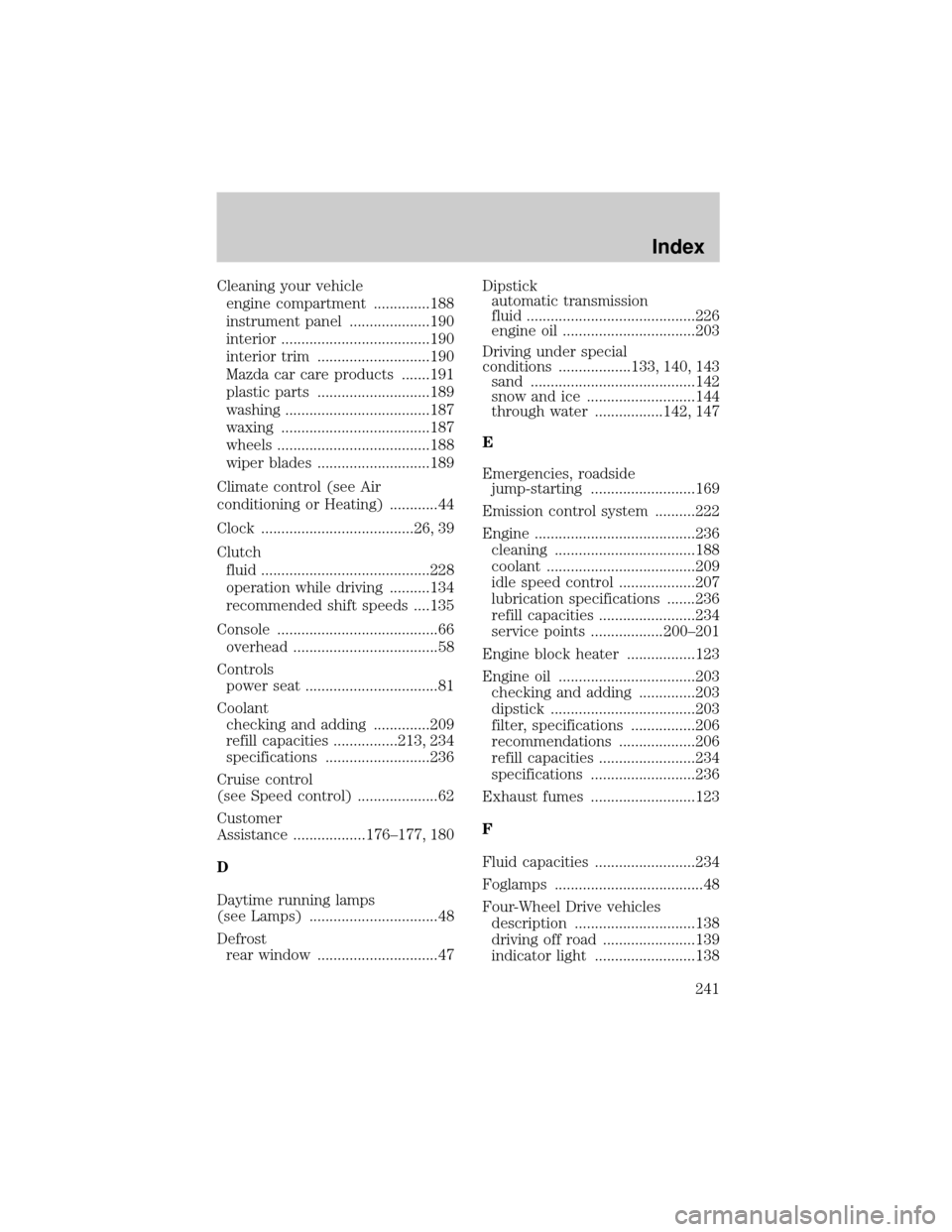Page 212 of 248

WARNING: To reduce the risk of personal injury, make sure the
engine is cool before unscrewing the coolant pressure relief
cap. The cooling system is under pressure; steam and hot liquid
can come out forcefully when the cap is loosened slightly.
1. Before you begin, turn the engine off and let it cool.
2. When the engine is cool, wrap a thick cloth around the coolant
pressure relief cap on the coolant reservoir (an opaque plastic
bottle). Slowly turn cap counterclockwise (left) until pressure begins
to release.
3. Step back while the pressure releases.
4. When you are sure that all the pressure has been released, use the
cloth to turn it counterclockwise and remove the cap.
5. Fill the coolant reservoir slowly with the proper coolant mixture (see
above), to within the ªcold fill rangeº or the ªcold fullº level on the
reservoir. If you removed the radiator cap in an overflow system, fill
the radiator until the coolant is visible and radiator is almost full.
6. Replace the cap. Turn until tightly installed. (Cap must be tightly
installed to prevent coolant loss.)
After any coolant has been added, run the engine for a few minutes to
mix the coolant. Check the coolant concentration. Make sure the engine
is off and cool before removing the coolant pressure relief cap (see
preceding steps on cap removal). Check the concentration per the
Checking Engine Coolantsection. If the concentration is not 50/50
(protection to ±34ÉF/±36ÉC), drain some coolant and adjust the
concentraction. It may take several drains and additions to obtain a 50/50
coolant concentration.
Whenever coolant has been added, the coolant level in the coolant
reservoir should be checked the next few times you drive the vehicle. If
necessary, add enough 50/50 concentration of engine coolant and
distilled water to bring the liquid level to the proper level.
If you have to add more than 1.0 liter (1.0 quart) of engine coolant per
month, have your dealer check the engine cooling system. Your cooling
system may have a leak. Operating an engine with a low level of coolant
can result in engine overheating and possible engine damage).
Maintenance and Specifications
212
Page 218 of 248

Running out of fuel
Avoid running out of fuel because this situation may have an adverse
affect on powertrain components.
If you have run out of fuel:
²You may need to cycle the ignition from OFF to ON several times after
refueling, to allow the fuel system to pump the fuel from the tank to
the engine.
²The
indicator may come on. For more information on the ªCheck
Engineº indicator, refer to theInstrument Clusterchapter.
Fuel Filler Cap
Your fuel tank filler cap has an indexed design with a 1/8 turn on/off
feature.
When fueling your vehicle:
1. Turn the engine off.
2. Pull the fuel filler door release handle to open the fuel filler door.
3. Carefully turn the filler cap counterclockwise 1/8 of a turn until it
stops.
4. Pull to remove the cap from the fuel filler pipe.
5. To install the cap, align the tabs on the cap with the notches on the
filler pipe.
6. Turn the filler cap clockwise 1/8 of a turn until it stops.
After refueling, if the ªCHECK FUEL CAPº indicator comes on and stays
on when you start the engine, the fuel filler cap may not be properly
installed. Turn off the engine, remove the fuel filler cap, align the cap
properly and reinstall it securely. The indicator should turn off after
three driving cycles with the fuel filler cap properly installed. A driving
cycle consists of a cold engine start-up followed by mixed city/highway
driving.
If you must replace the fuel filler cap, replace it with a fuel filler
cap that is designed for your vehicle. The customer warranty may
be void for any damage to the fuel tank or fuel system if the
correct genuine Mazda fuel filler cap is not used.
Maintenance and Specifications
218
Page 241 of 248

Cleaning your vehicle
engine compartment ..............188
instrument panel ....................190
interior .....................................190
interior trim ............................190
Mazda car care products .......191
plastic parts ............................189
washing ....................................187
waxing .....................................187
wheels ......................................188
wiper blades ............................189
Climate control (see Air
conditioning or Heating) ............44
Clock ......................................26, 39
Clutch
fluid ..........................................228
operation while driving ..........134
recommended shift speeds ....135
Console ........................................66
overhead ....................................58
Controls
power seat .................................81
Coolant
checking and adding ..............209
refill capacities ................213, 234
specifications ..........................236
Cruise control
(see Speed control) ....................62
Customer
Assistance ..................176±177, 180
D
Daytime running lamps
(see Lamps) ................................48
Defrost
rear window ..............................47Dipstick
automatic transmission
fluid ..........................................226
engine oil .................................203
Driving under special
conditions ..................133, 140, 143
sand .........................................142
snow and ice ...........................144
through water .................142, 147
E
Emergencies, roadside
jump-starting ..........................169
Emission control system ..........222
Engine ........................................236
cleaning ...................................188
coolant .....................................209
idle speed control ...................207
lubrication specifications .......236
refill capacities ........................234
service points ..................200±201
Engine block heater .................123
Engine oil ..................................203
checking and adding ..............203
dipstick ....................................203
filter, specifications ................206
recommendations ...................206
refill capacities ........................234
specifications ..........................236
Exhaust fumes ..........................123
F
Fluid capacities .........................234
Foglamps .....................................48
Four-Wheel Drive vehicles
description ..............................138
driving off road .......................139
indicator light .........................138
Index
241
Page:
< prev 1-8 9-16 17-24